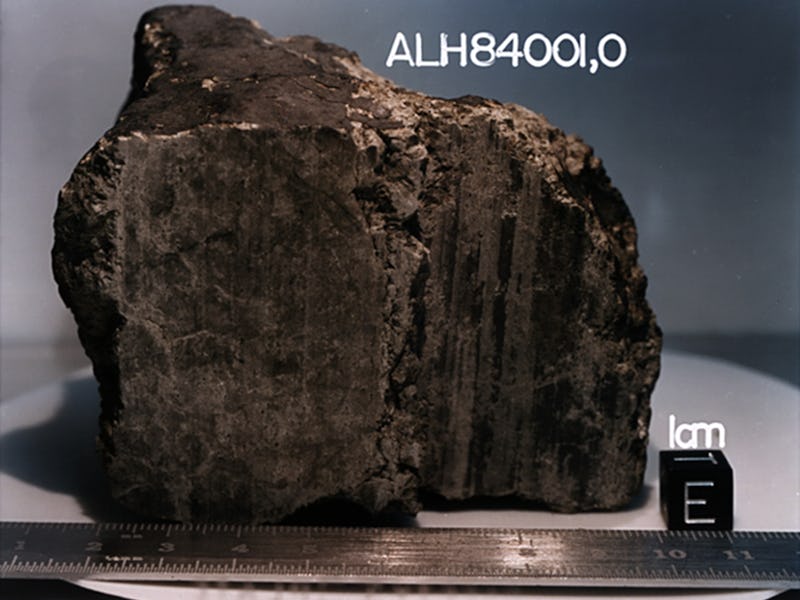Ancient Martian meteorite holds clues to life on Mars
The Red Planet may have been more 'Earth-like' at some point.

On December 27, 1984, a meteorite hunting expedition in Antartica found a black rounded brick, measuring at 6 by 4 by 3 inches. ALH 84001 made its way to Earth from Mars, and the meteorite contained traces of the Red Planet's early history and possible early life.
A team of researchers probing at the Martian rock recently found traces of organic molecules hidden in ALH 84001, providing further evidence that Mars may have once contained one of the crucial building blocks of life.
The study, published this week in the journal Nature, also serves as proof that early traces of life can be preserved for millions of years, and detected today.
A rock fragment of the Martian meteorite ALH 84001 (left) and an enlarged view (right) shows the orange-colored carbonate grains.
The team of researchers behind the new study analyzed samples of ALH 84001, and detected nitrogen-bearing organic material in carbonate minerals, which generally form in groundwater. Therefore, the findings not only hint at past life on Mars, but that the dry and desolate Red Planet we know today may have at one point been a wet, habitable world similar to Earth.
The new finding also supports ongoing investigations into organic molecules found on Mars.
In 2018, NASA's Curiosity rover found organic molecules in 3-billion-year-old sedimentary rocks near the Martian surface.
Organic molecules contain carbon and hydrogen, and may also include oxygen, nitrogen and other elements. They are generally associated with some form of life, although organic molecules are not a definitive proof of life. While traces of organic molecules have been found before on Mars, this recent study is the first to find ones containing nitrogen.
For the study, the team used a type of X-ray spectroscopy to detect nitrogen in ALH84001 and trace it to the carbonate minerals. ALH84001, is presumably 4.091 billion years old, and one of the oldest objects in the solar system to have ever made its way to Earth. Scientists believe that the pice of rock was ejected from Mars by another meteorite strike that sent it flying through space before finally landing on our planet.
In order to ensure that the meteorite had not been contaminated by other objects during its journey from Mars to Earth, the team plucked off tiny carbonate grains, which are about the width of a human hair, from the meteorite. They then removed possible surface contaminants with a scanning electron microscope-focused ion beam instrument at the Japan Aerospace Exploration Agency (JAXA).
The study suggests that the nitrogen-bearing organic compounds may have gotten trapped in the minerals 4 billion years ago, and preserved in the Martian rock that made its way to Earth.
As for how the organic material reached Mars in the first place, the team of researchers suggest that they either formed on the planet, or came from outside of Mars.
"Early in the Solar System’s history, Mars was likely showered with significant amounts of organic matter," Atsuko Kobayashi from the Earth-Life Science Institute (ELSI) at Tokyo Institute of Technology, Japan, and lead author of the new study, said in a statement. "For example from carbon-rich meteorites, comets and dust particles. Some of them may have dissolved in the brine and been trapped inside the carbonates."
On the other hand, chemical reactions on Mars during its early history may have produced the nitrogen-bearing organics on the planet itself.
In the search for ancient life on Mars, scientists are still trying to understand where these organic molecules come from, and whether they are related to some form of biochemical activity on the Red Planet.
Abstract: Understanding the origin of organic material on Mars is a major issue in modern planetary science. Recent robotic exploration of Martian sedimentary rocks and laboratory analyses of Martian meteorites have both reported plausible indigenous organic components. However, little is known about their origin, evolution, and preservation. Here we report that 4-billion-year-old (Ga) carbonates in Martian meteorite, Allan Hills 84001, preserve indigenous nitrogen(N)-bearing organics by developing a new technique for high-spatial resolution in situ N-chemical speciation. The organic materials were synthesized locally and/or delivered meteoritically on Mars during Noachian age. The carbonates, alteration minerals from the Martian near-surface aqueous fluid, trapped and kept the organic materials intact over long geological times. This presence of N-bearing compounds requires abiotic or possibly biotic N-fixation and ammonia storage, suggesting that early Mars had a less oxidizing environment than today.